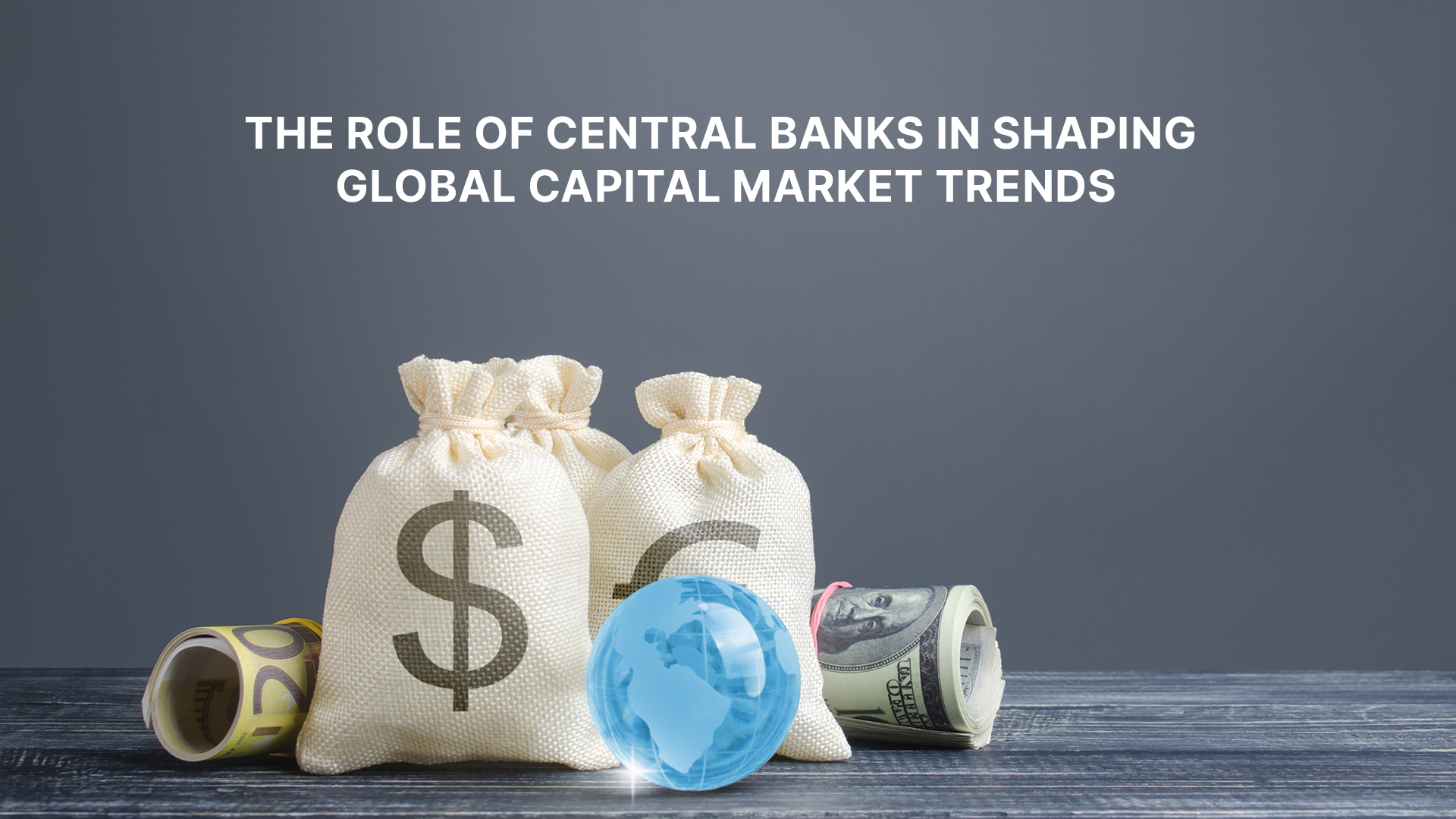Global capital markets are constantly evolving, shaped by a wide range of economic, political, and structural factors. Among the most influential forces in this landscape are central banks. Through their role in setting monetary policy, maintaining financial stability, and guiding market expectations, central banks not only act as custodians of national economies but also exert powerful influence over global investment flows, valuations, and risk sentiment.
For businesses, investors, and financial institutions operating across borders, understanding how central banks shape market trends is vital. Decisions made in Washington, Frankfurt, London, Tokyo, or Beijing can ripple across equity indices, bond markets, currencies, and commodities within hours.
At Global Banking and Markets (GBM), where our mission is to create a platform for deal-making, networking, and knowledge exchange across regions, we recognise that central bank actions are at the very core of the capital markets narrative. In this article, we explore the fundamental ways central banks impact markets and why their influence matters for global finance.

Core Functions Impacting Capital Markets
Interest Rate Policy
At the heart of central banking is the setting of benchmark interest rates. These rates determine the cost of borrowing for businesses and consumers and influence the relative attractiveness of asset classes.
- Low interest rates tend to stimulate economic activity by reducing financing costs, encouraging investment, and lifting equity and real estate valuations. They also incentivise investors to seek higher returns in riskier assets, such as equities, emerging markets, or alternative investments.
- High interest rates, on the other hand, tighten financial conditions, reduce liquidity, and often place downward pressure on valuations. For bond markets, rising yields can erode prices, while equity markets typically see reduced growth expectations reflected in earnings multiples.
The recent cycle of global interest rate hikes has been a stark reminder of how quickly central bank decisions can shift capital markets. For international dealmakers and investors, these dynamics shape everything from the pricing of cross-border loans to the appetite for mergers and acquisitions.

Monetary Policy Tools
Beyond setting interest rates, central banks wield a wide array of tools to manage liquidity and credit conditions. These include:
- Quantitative Easing (QE): Large-scale asset purchases that inject liquidity into financial systems, often leading to rising asset prices and greater risk appetite.
- Open Market Operations: Day-to-day buying and selling of government securities to maintain target interest rates.
- Targeted Lending Facilities: Special schemes to channel liquidity to specific parts of the economy, often deployed in times of stress.
During the COVID-19 pandemic, unprecedented QE and liquidity provision by central banks stabilised markets, drove down yields, and helped fuel a strong rebound in equities. For issuers and borrowers, these measures dramatically reduced funding costs and reopened debt markets.

Forward Guidance and Communication
Markets are not only shaped by what central banks do but also by what they say. Forward guidance – the communication of future policy intentions – is a powerful tool for influencing investor expectations.
- Transparent and credible guidance reduces uncertainty, stabilises markets, and allows businesses to plan with confidence.
- Surprise policy shifts or unclear communication, however, can increase volatility, as seen when the US Federal Reserve’s tapering of QE in 2013 sparked a “taper tantrum” across global markets.
In today’s interconnected environment, even the tone of a central banker’s speech can spark currency swings, repricing of bond yields, or reallocation of capital flows across borders.
Maintaining Stability and Confidence
Central banks play a crucial role in ensuring that financial markets remain stable, resilient, and functional.
Financial Crisis Response
As lenders of last resort, central banks provide emergency funding during times of market stress. By extending liquidity, they prevent panic, restore confidence, and protect against systemic collapse. The 2008 financial crisis illustrated the importance of coordinated central bank interventions in averting a deeper global depression.
Regulation and Supervision
Central banks often oversee the health of commercial banks and broader financial systems. Through regulation, stress testing, and capital requirements, they reduce systemic risks. By ensuring financial institutions are sound, they indirectly make capital markets safer and more attractive for investors.
Payment System Anchor
At the core of every financial transaction lies the settlement process, which relies on central bank money as its ultimate anchor. From domestic transfers to cross-border settlements, central banks underpin the trust and reliability of payment systems, which are vital for trade, investment, and capital flows.
Influence on Global Trends
The globalised nature of finance means that central banks rarely act in isolation. Their decisions often have cross-border consequences.
International Coordination
In moments of crisis, international collaboration among central banks has proven essential. For example, during the COVID-19 pandemic, coordinated liquidity provision and swap lines between major central banks helped stabilise the global financial system. Such actions highlight how central banking has evolved into a cooperative function with global implications.
Exchange Rate Management
Many central banks intervene in currency markets to maintain stability and competitiveness. Exchange rates influence international trade, foreign investment flows, and corporate earnings. For multinational businesses, the actions of central banks in managing exchange rates can significantly alter deal structures, hedging strategies, and valuations.
Investor Sentiment
Ultimately, the credibility, independence, and responsiveness of central banks shape global investor sentiment. Markets reward central banks that demonstrate autonomy, transparency, and a steady hand. Conversely, doubts about credibility – whether due to political interference or delayed policy action – can trigger volatility, capital outflows, and declining investor confidence.
Summary: Central Bank Actions & Market Effects
|
Central Bank Action |
Capital Market Impact |
|
Interest rate changes |
Asset prices, borrowing costs |
|
Quantitative easing |
Market liquidity, valuations |
|
Forward guidance |
Market expectations, volatility |
|
Financial crisis support |
Systemic stability, panic prevention |
|
Exchange rate interventions |
Global capital flows, trade stability |
Why This Matters for Global Banking and Markets
For participants in the global financial ecosystem – from banks and investors to corporates and governments – central banks are the silent architects of market conditions. Their decisions shape the cost of capital, determine the availability of liquidity, and influence the appetite for risk.
At Global Banking and Markets (GBM), our role is to provide the infrastructure where these dynamics can be understood, debated, and acted upon. Through our events and networking platforms, we bring together the brightest minds in finance – policymakers, investors, issuers, and advisers – to exchange insights, navigate uncertainty, and seize opportunities.
By connecting stakeholders across borders, GBM creates a unique space where central bank policy meets market practice. Whether you are structuring a cross-border acquisition, managing a global investment portfolio, or issuing bonds in international markets, understanding the role of central banks is essential – and GBM is where those conversations happen.
In today’s interconnected financial world, knowledge is not just power – it is opportunity. GBM is more than an events organiser: we are a global ecosystem for banking, investment, and capital markets professionals. Our platforms facilitate cross-border deals, foster meaningful relationships, and provide the intelligence you need to stay ahead of market shifts driven by central banks and other macroeconomic forces.
Join us at GBM to engage with global leaders, exchange insights, and unlock opportunities across emerging and developed markets. Together, we shape the future of finance.
We are the world leader in global markets-focused financing events in emerging markets. We bring complex markets together in one place at one time, facilitate informal networking & organise meetings which accelerate deal-flow. Connecting you with business partners and counterparties is at the heart of everything we do.
.png)


.png)

